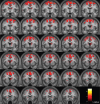Distinct neural substrates of duration-based and beat-based auditory timing
- PMID: 21389235
- PMCID: PMC3074096
- DOI: 10.1523/JNEUROSCI.5561-10.2011
Distinct neural substrates of duration-based and beat-based auditory timing
Abstract
Research on interval timing strongly implicates the cerebellum and the basal ganglia as part of the timing network of the brain. Here we tested the hypothesis that the brain uses differential timing mechanisms and networks--specifically, that the cerebellum subserves the perception of the absolute duration of time intervals, whereas the basal ganglia mediate perception of time intervals relative to a regular beat. In a functional magnetic resonance imaging experiment, we asked human subjects to judge the difference in duration of two successive time intervals as a function of the preceding context of an irregular sequence of clicks (where the task relies on encoding the absolute duration of time intervals) or a regular sequence of clicks (where the regular beat provides an extra cue for relative timing). We found significant activations in an olivocerebellar network comprising the inferior olive, vermis, and deep cerebellar nuclei including the dentate nucleus during absolute, duration-based timing and a striato-thalamo-cortical network comprising the putamen, caudate nucleus, thalamus, supplementary motor area, premotor cortex, and dorsolateral prefrontal cortex during relative, beat-based timing. Our results support two distinct timing mechanisms and underlying subsystems: first, a network comprising the inferior olive and the cerebellum that acts as a precision clock to mediate absolute, duration-based timing, and second, a distinct network for relative, beat-based timing incorporating a striato-thalamo-cortical network.
Figures





References
-
- Artieda J, Pastor MA, Lacruz F, Obeso JA. Temporal discrimination is abnormal in Parkinson's disease. Brain. 1992;115:199–210. - PubMed
-
- Ashburner J. A fast diffeomorphic image registration algorithm. Neuroimage. 2007;38:95–113. - PubMed
-
- Barnes R, Jones MR. Expectancy, attention, and time. Cogn Psychol. 2000;41:254–311. - PubMed
-
- Belin P, Zatorre RJ, Hoge R, Evans AC, Pike B. Event-related fMRI of the auditory cortex. Neuroimage. 1999;10:417–429. - PubMed
Publication types
MeSH terms
Grants and funding
LinkOut - more resources
Full Text Sources
